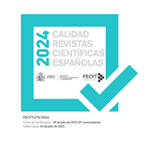Análisis automático de la complejidad sintáctica de textos escolares
Resumen
El objetivo del presente estudio fue comparar, por medio de una herramienta de análisis automático, la complejidad sintáctica de los textos utilizados para comunicar el conocimiento en los textos escolares de tres asignaturas de educación básica o primaria (Lenguaje y Comunicación, Ciencias Naturales e Historia Geografía y Ciencias Sociales). Para ello, se recolectó un corpus compuesto por 2121 instancias del género Exposición de Contenido (Ibáñez, Moncada, Cornejo y Arriaza, 2017), presentes en los textos escolares de sexto, séptimo y octavo básico, entregados por el Estado de Chile a las y los estudiantes de colegios públicos. Tales instancias fueron sometidas a un análisis automático, por medio de un algoritmo que permite identificar las relaciones de dependencia sintáctica entre los constituyentes de una oración y, del mismo modo, calcular la Longitud de Dependencia Sintáctica (LDS) promedio de la misma. Los resultados revelaron que la LDS promedio de los textos analizados, correspondientes a diferentes cursos y asignaturas es homogéneamente baja. Del mismo modo, se observó que no existe un patrón de complejización a medida que avanzan los cursos. También quedó en evidencia que, si bien no fue posible apreciar patrones disciplinares que permitieran determinar la existencia de asignaturas con mayor CS, si existe una tendencia que sitúa a Historia Geografía y Ciencias Sociales como la más compleja de las asignaturas analizadas, en términos de configuración sintáctica.
Descargas
Descarga artículo
Licencia
La revista Círculo de Lingüística Aplicada a la Comunicación, para fomentar el intercambio global del conocimiento, facilita el acceso sin restricciones a sus contenidos desde el momento de su publicación en la presente edición electrónica, y por eso es una revista de acceso abierto. Los originales publicados en esta revista son propiedad de la Universidad Complutense de Madrid y es obligatorio citar su procedencia en cualquier reproducción total o parcial. Todos los contenidos se distribuyen bajo una licencia de uso y distribución Creative Commons Reconocimiento 4.0 (CC BY 4.0). Esta circunstancia ha de hacerse constar expresamente de esta forma cuando sea necesario. Puede consultar la versión informativa y el texto legal de la licencia.











